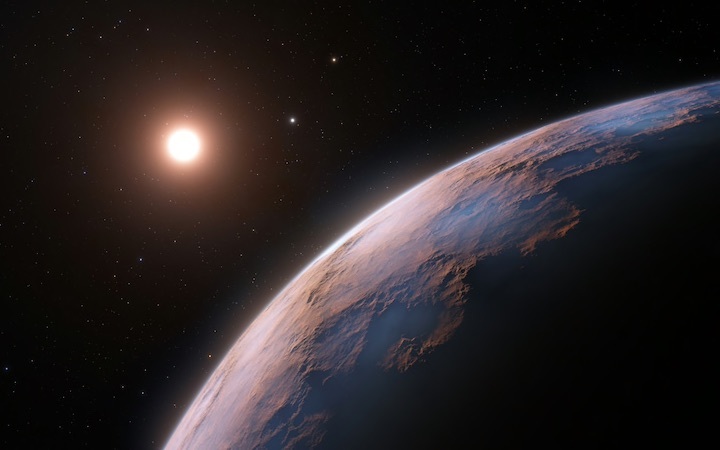19.02.2022
The finding is a breakthrough in the way astronomers search for planets around distant stars, which could soon lead to the discoveries of even more worlds.

An artist’s impression shows a close-up view of Proxima d, a planet candidate recently found orbiting the red dwarf star Proxima Centauri, the closest star to Earth's solar system.ESO / L. Calçada
Astronomers have found evidence of a third planet around the closest star to the sun, reinforcing the idea that planets are common around the stars of the galaxy, even some of its smallest.
And while the newly-found planet is less than half the size of Earth and probably too hot to be inhabited, there’s still a chance there could be life around Proxima Centauri, Earth’s nearest galactic neighbor.
“The planet is not within the star’s habitable zone — it’s orbiting too close,” said astronomer João Faria, the lead author of a study published this month in the journal Astronomy & Astrophysics that details the discovery. “So it’s unlikely that water can be in a liquid state and that the conditions are right for life.”
In fact, the new planet is so close — about a tenth of the distance between the sun and Mercury — that it takes just five days to complete an orbit around its star.
It’s also likely to be “tidally locked,” as the moon is to Earth, with one face always pointing toward Proxima Centauri. That could cause extremes of temperature and limits the likelihood that the planet has a stable atmosphere, Faria said.
But astronomers are excited by the discovery, despite the hostile conditions that could exist on the new planet.
Faria, a researcher at the Institute of Astrophysics and Space Sciences at the University of Porto in Portugal, said it suggests the Proxima system could be “packed with planets.”
It’s also a breakthrough in the way astronomers search for planets around distant stars, which could soon lead to the discovery of even more, he said in an email.
The new planet will have to be verified by other observations, but Faria and his co-authors say they detected it in tiny variations in Proxima’s starlight — “wobbles” caused by the planet’s gravity.
Similar techniques were used to detect the first planet found around Proxima in 2016, and a second planet in 2019.
But the latest search used light gathered by a new spectrograph at the Very Large Telescope on a mountaintop in the Atacama Desert of northern Chile — a more sensitive instrument than used before.
NASA’s James Webb space telescope to travel 1 million miles from Earth
“We are now able, in terms of instrumental precision, to detect such small signals, which opens the possibility of finding planets like the Earth around stars like the sun in the not-so-distant future,” Faria said.
Proxima Centauri is the third star of the Alpha Centauri system, which looks like a single bright star from Earth.
It’s just over four light-years away, or about 25 trillion miles — but despite that vast distance, it’s the closest star system.
Only the light from its two brightest stars, Alpha Centauri A and Alpha Centauri B, can be seen with the naked eye.
They orbit each other, but far enough apart that they’re thought not to interfere with each other’s planets.
And because Alpha Centauri A and B are both remarkably like the sun, it’s possible life could have evolved on their planets or moons — so scientists plan to look for them with a dedicated space telescope.
Proxima Centauri, on the other hand, is a small and very dim red dwarf star discovered by telescope in 1915, far away from the system’s two main stars.
Technically, Proxima is the closest star to the sun — about a trillion miles closer than the others — until its orbit takes it further away in about 25,000 years (its name comes from the Latin word for “nearest”).
Unlike Alpha Centauri A and B, where no verified planets have been found, three planets have now been detected around Proxima.
None of them are thought to be very similar to Earth, however, because Proxima is an active “flare star” that regularly doses its planets with bursts of intense radiation.
But it’s still possible that life could have evolved on at least one of its planets, said Guillem Anglada-Escudé, an astronomer at the Institute of Space Sciences in Barcelona, Spain.
He led the team that announced Proxima’s first planet in 2016. That planet was found to be about the size of Earth and within Proxima’s narrow habitable or “Goldilocks” zone, where it’s neither too hot nor too cold — “just right” — for oceans of water on its surface.
Observations now suggest there may actually be oceans there; and if that’s the case, they could replenish atmospheric gases stripped away by Proxima’s frequent flares, he said. Oceans could also act as a barrier to the flares, and so it’s possible that marine life may have evolved.
Anglada-Escudé expects more planets will be found around Proxima Centauri and other stars as astronomical instruments and techniques improve.
“Within a decade, we should be able to detect these planets directly,” he said. “The idea will be to search for life, to see from the spectrum of a planet if there are chemicals that cannot be explained by other natural processes.”
Quelle: NBC News

